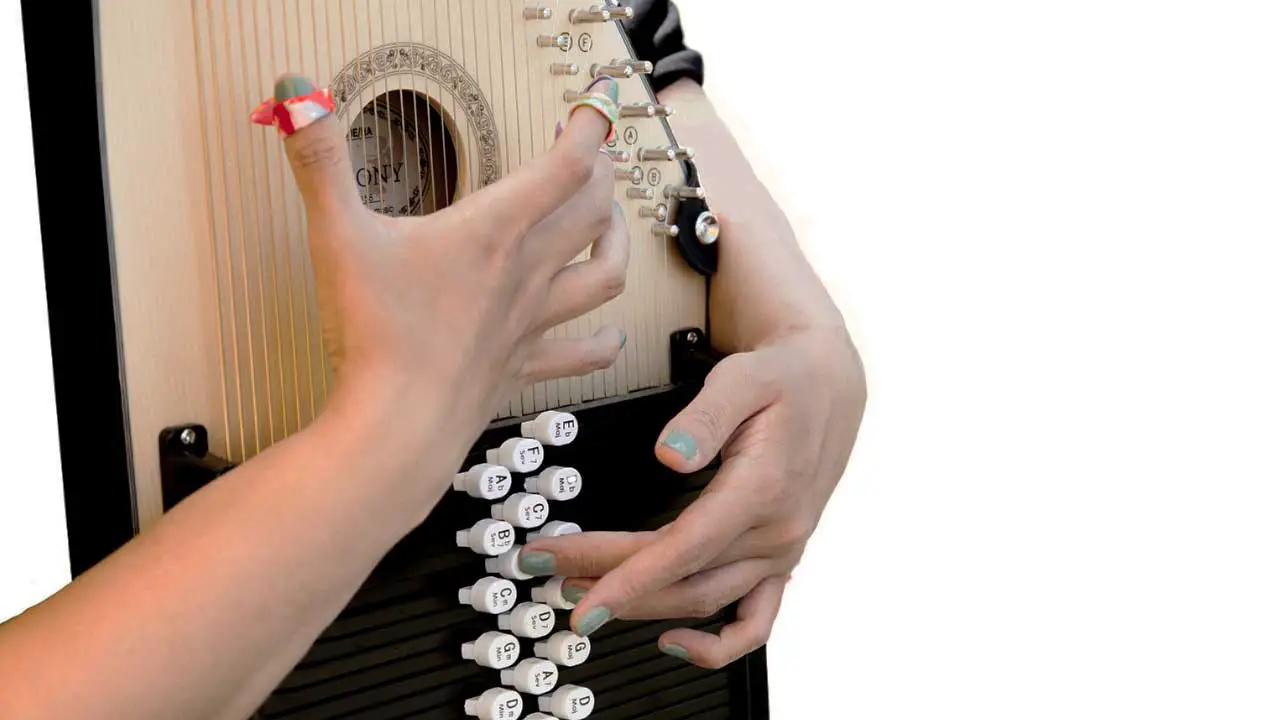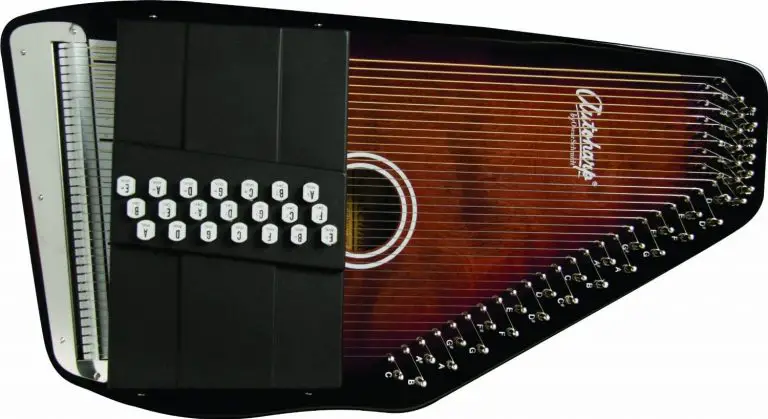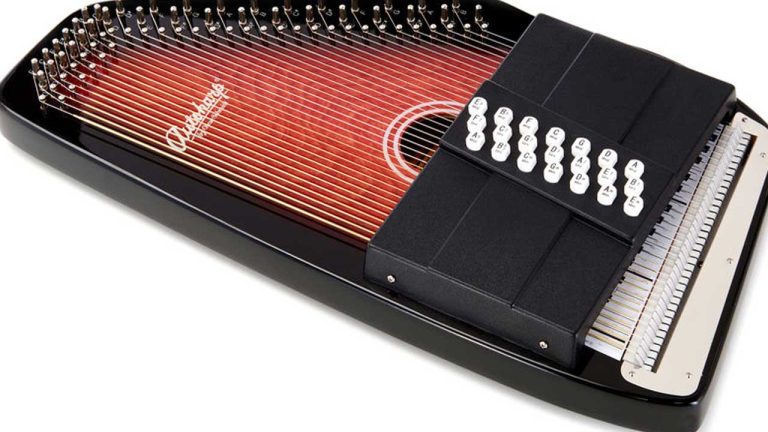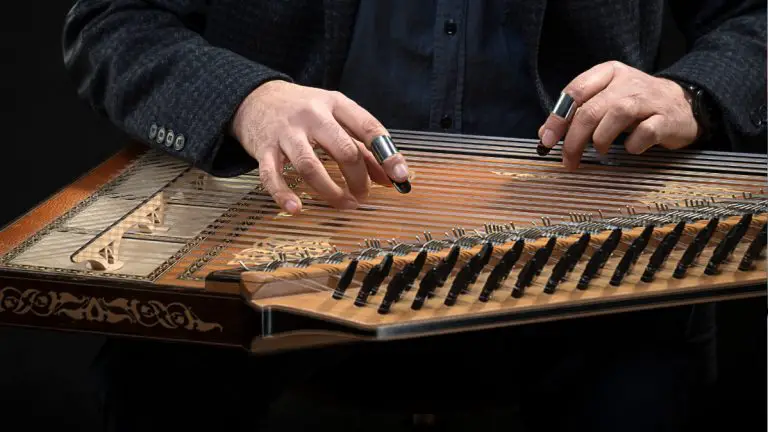Where Is the Best Place to Buy an Autoharp? Your Top Picks Reviewed
Folkstrings.com is reader-supported. When you buy through links on our site, we may earn a small commission.
Choosing the best place to buy an autoharp is important. It affects the quality of the instrument you get and your access to after-sales support and potential community involvement.
Whether you’re just starting out or are an experienced musician looking to upgrade, the vast array of autoharps can seem daunting. The different numbers of chords, configurations, and modifications make it harder to choose.
I’ve found that it’s essential to consider the credibility of the seller, the quality of the instruments they offer, and any value-added services such as customizable options or lessons.
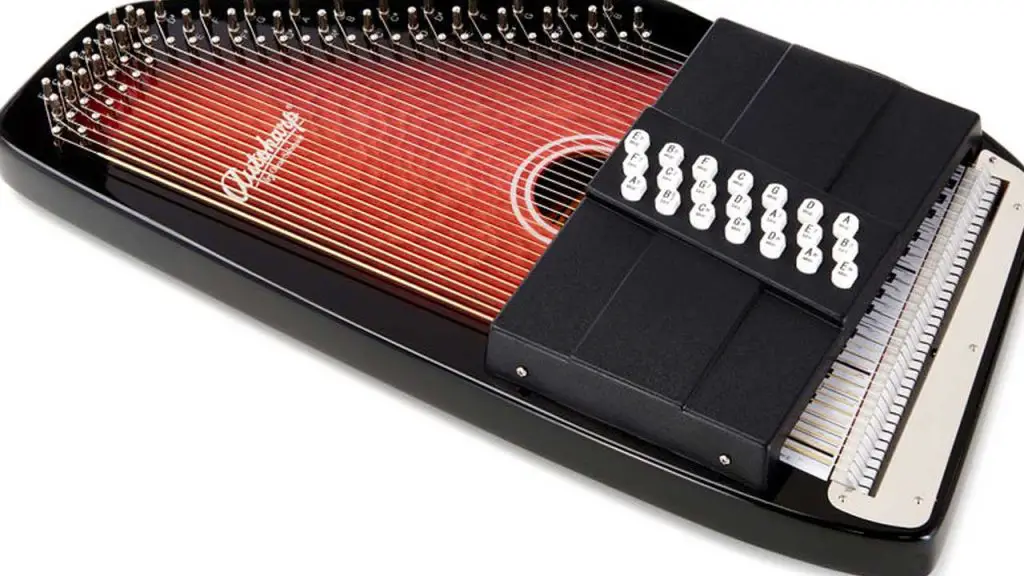
I recommend looking for a retailer or luthier who specializes in folk instruments. They should offer not only a wide selection of autoharps but also guidance on choosing the right one.
You’d be surprised how much difference the right setup can make. So, it’s worth seeking out experts who can help you find an autoharp that suits your personal playing style.
Some stores even offer the opportunity to try out different autoharps. This is an invaluable experience when you’re trying to find the perfect instrument.
Online marketplaces and music stores are common places to purchase an autoharp. But don’t overlook local music shops and folk festivals, which can sometimes offer unexpected gems.
One thing is clear: no matter where you buy your autoharp, make sure they can offer assistance in tuning, teach you maintenance tips, and support you with the right accessories.
Key Takeaways
- Finding an autoharp with the right chord setup enhances playing satisfaction.
- Expert advice can significantly help in setting up and maintaining the instrument.
- The ideal purchase includes accessible post-sale support for any inquiries or needs.
Choosing the Right Autoharp
When you’re on the hunt for an autoharp, two crucial aspects you’ll want to focus on are the quality of the instrument and the differences between popular models. These can affect the playability and the sound, so I’ll help you understand what to look out for.
Identifying Quality Autoharps
High-quality autoharps have a few telltale signs. First, I check for the top wood, as this affects the sound. Mahogany tops, for example, tend to produce a warm tone.
A solid construction is also key, so I prefer autoharps with a satin or sunburst finish that not only look stunning but also offer durability.
Chromaharp and Oscar Schmidt are reliable brands to consider. For Oscar Schmidt, the OS21C is often hailed as the best due to its traditional design and quality sound.
When it comes to chords, options vary between 15 and 21 chords. More chords mean more versatility, but if you’re a beginner, a 15-chord autoharp like the OS15B might be simpler to start with.
For an intermediate to advanced player, a 21-chord autoharp like the OS21C or OS11021AE would offer a broader range of musical possibilities.
Comparing Popular Models
In the Oscar Schmidt lineup, the OS45CE is an “Appalachian electric autoharp” that’s a go-to for performers wanting an amplified sound. With its sleek design and a robust set of 21 chord bars, my experience says it’s a hit for live performances.
For a traditional feel, the OS73B and OS73C models, resembling designs from the 1930s, are visually stunning and provide that classic autoharp sound.
Both offer the choice between 15 and 21 chords, but I notice the 21-chord versions, like the OS73C, allow for greater musical complexity.
The Chromaharp 21, alternatively, is great for classrooms or beginner musicians due to its ease of play and maintenance.
When comparing these models, I look at aspects such as the number of strings, chord bars, and whether they come with accessories, which many Oscar Schmidt models do.
Now, when you’re evaluating the best autoharp for you, consider the types of music you want to play, your skill level, and whether you’re looking for something with electric capabilities.
It can be hard to choose the “best” since it’s so personal, but Oscar Schmidt’s range, especially models like the OS21C and OS45CE, tend to meet a broad array of needs with their quality and features.
Mastering the Setup
In my experience, the true potential of an autoharp emerges once it is properly set up. This setup process primarily centers around ensuring the instrument is well-tuned and the chord bars are correctly positioned. Let me share some essential tips on how to get this exactly right.
Autoharp Tuning Essentials
I always start with the tuning. A well-tuned autoharp sounds heavenly, but it does require patience and a bit of know-how. Here’s what you need to make sure your autoharp is in perfect pitch:
- Tuner: I recommend using a chromatic tuner for precision. It can really make the task less daunting, especially for a beginner.
- Tuning Wrench: The tuning wrench, or key, is what you’ll need to turn the tuning pins. Make sure it fits properly; a loose wrench can damage the pins.
- Tuning System: Autoharps commonly come with 21 or 15 chords. Each string corresponds to multiple chords, so you need to follow a standard tuning system that aligns with your autoharp’s chord range.
- Fine Tuning: After you get each string to the correct note, go back and fine-tune. Strings can sometimes slip out of tune during the process, especially new ones.
As I tune, I check the strings in the context of the chord bars as well, to ensure everything sounds harmonious.
Understanding the Chord Bars
Once tuning is handled, I turn my attention to the chord bars:
- For autoharps with 21 chords, you’ll have a rich selection to work with, which is fantastic for versatility.
- 15 chords autoharps offer a more pared-down selection, which may be easier for beginners to manage.
To set up the chord bars:
- Each chord bar should be fitted with felt pads that mute the strings not in the chord, allowing only the correct strings to ring.
- I check to make sure no additional strings are being accidentally muted or allowed to ring. This is crucial for a clean sound.
- Adjustments to the bars themselves might be needed to properly align them over the strings.
Remember, setting up an autoharp is not something you rush through. It’s a careful process that, when done correctly, results in a beautifully harmonious instrument that’s a joy to play and hear.
Playing Techniques and Maintenance
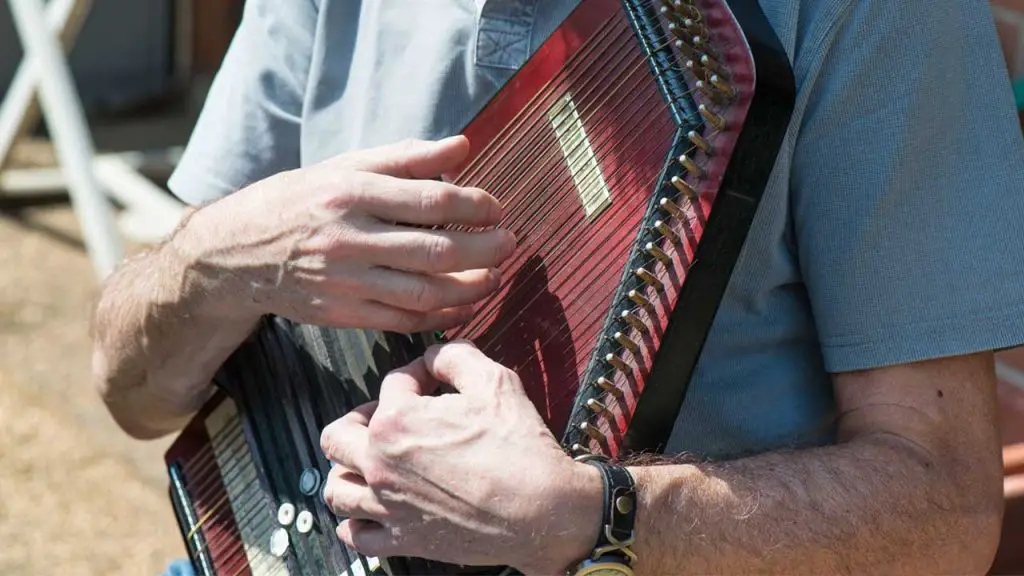
When I picked up my first autoharp, I quickly learned that the joy of playing this versatile instrument comes hand in hand with a commitment to its care. Let me share some key insights on how to master playing techniques and maintain your autoharp to keep the music flowing beautifully.
Learning Basic to Advanced Playing
Starting as a beginner, I found that learning the autoharp’s basic playing techniques was quite accessible. Initially, I practiced simple strumming and finger-picking patterns.
As I progressed, I employed more complex techniques such as pinch plucks and melody playing. Here’s a brief guide based on my experience:
- Strumming: A foundational skill where I used a flat pick to strum across the strings.
- Finger Picks: These are essential for clear, louder notes, especially favored for melody playing.
- Chord Progressions: Knowing the autoharp’s chord bar layout helped me learn and remember the most common progressions.
- Melody Playing: I played individual notes to create melodies, often combining with chord strums for richer tunes.
The journey from basic strumming to performing full melodies was incredibly rewarding. It required patience and practice, but I found a wealth of resources online, from beginner-friendly tutorials to advanced workshops, which helped me hone my skill levels.
Maintaining Your Autoharp
Maintenance is crucial to keep the autoharp in top condition, and I take it seriously. Here’s what I focus on:
- Regular Tuning: Autoharps have a complex tuning system. Regular tuning is a must, and I always ensure that I have a reliable tuning wrench and electronic tuner.
- Cleanliness: I wipe down my autoharp after each use to maintain the gloss finish and keep it looking pristine.
- Storage: A gig bag or hard case protects the instrument from dust and damage. I always store mine in a safe, dry place to prevent warping or string corrosion.
- String Replacement: I check for worn strings and replace them as needed to prevent unexpected breaks.
Accessories and Enhancements
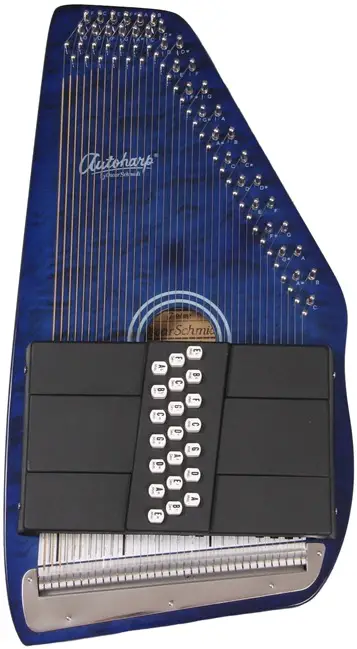
When I bought my autoharp, I learned that accessories are vital for both maintaining my instrument and enhancing my playing experience. Let me guide you through my picks for getting the best out of your autoharp.
Tuning Wrench:
Essential for keeping your autoharp in tune, a good tuning wrench is a must-have. I prefer ones with a comfortable grip, as it makes the tuning process a lot more pleasant.
Fine-Tuning System:
While tuning with a wrench works well, I appreciate the precision a fine-tuning system offers. It’s especially helpful during performances where I need to make quick adjustments.
Assortment of Picks:
The right pick can make a world of difference. Here’s my go-to variety:
- Thumb Picks: Enhance plucking precision.
- Finger Picks: Protect my fingers and boost sound clarity.
Gig Bag:
Protecting my autoharp with a durable gig bag makes me feel secure when transporting it. Look for one with pockets for extra storage space.
| Accessory | Purpose | My Advice |
|---|---|---|
| Tuning Wrench | Tuning your autoharp | Get a grip-friendly one |
| Fine-Tuning System | Precise tuning adjustments | Invest if you frequently perform |
| Assortment of Picks | Better sound and protection for fingers | Start with a few varieties to find your favorite |
| Gig Bag | Convenient transportation and protection | Choose one with extra storage |
Warranty:
Peace of mind comes with a warranty. I always check for this when I purchase any accessory. Knowing that I can have it replaced or repaired if there’s an issue is reassuring.
Frequently Asked Questions

When it comes to buying an autoharp, I know you’ve got questions. I’ve gathered the most common inquiries to help you make an informed decision.
What are trusted online retailers for purchasing an autoharp?
Trusted online retailers for autoharps include large online marketplaces like Amazon and eBay, as well as specialty music stores such as Elderly Instruments and Sweetwater. Purchasing from a reputable source ensures you receive a quality product and have customer support.
How do you choose the best autoharp for beginners?
For beginners, look for an autoharp that is user-friendly, with clearly marked chord buttons and a comfortable shape. Durability and a reasonable price are also important as you learn and determine your preferences.
What features should I look for when buying an autoharp?
Key features include the number of chord bars, quality of tuning system, type of wood, and construction. High-quality strings and a sturdy carrying case are also valuable for maintaining your instrument and making it portable.
Are there specific brands of autoharps recommended by experts?
Brands like Oscar Schmidt and ChromaHarp are often recommended by experts due to their long-standing reputations for quality craftsmanship and sound. These brands offer a range of models suitable for various skill levels.
What is the average cost range for a quality autoharp?
A quality autoharp can range from $200 to over $1,000, depending on the brand, materials used, and number of chord bars. Typically, mid-range instruments are suitable for most players and offer a good balance between quality and price.
How do the number of chords on an autoharp affect its playability?
The number of chords determines the range of songs you can play.
Autoharps with 15 to 21 chord bars are common. They provide a good variety for beginners to intermediate players. More chord bars allow for greater musical complexity but can also make the instrument more challenging to play.
Author Profile
-
Daniel Johnstone is an English writer with a love for stringed instruments from around the world.
He shares his love for these instruments through his writing for folkstrings.com, a website dedicated to all things related to folk string music.
Daniel's passion for music started at a young age, and he has since become an accomplished musician, playing guitar, cavaco, and recently, the harp.
His dedication to learning and sharing his knowledge of stringed instruments is evident in his insightful and engaging blog posts. Whether you're a seasoned musician or a beginner, Daniel's writing is sure to inspire and entertain you.
When he's not playing music or writing, you can find Daniel exploring new instruments and seeking out new sounds to share with his readers.
Latest entries
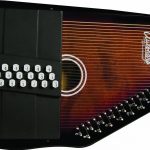 AutoharpApril 4, 2024What Is the Autoharp Made Of: Exploring Its Materials and Craftsmanship
AutoharpApril 4, 2024What Is the Autoharp Made Of: Exploring Its Materials and Craftsmanship AutoharpApril 4, 2024Is Autoharp Easy to Play? Unveiling the Truth for Beginners
AutoharpApril 4, 2024Is Autoharp Easy to Play? Unveiling the Truth for Beginners AutoharpApril 4, 2024What Is an Autoharp Worth? Your Guide to Pricing and Value
AutoharpApril 4, 2024What Is an Autoharp Worth? Your Guide to Pricing and Value AutoharpApril 4, 2024Are Autoharp and Zither the Same Thing? Unraveling String Instrument Myths
AutoharpApril 4, 2024Are Autoharp and Zither the Same Thing? Unraveling String Instrument Myths
Affiliates:
This post may contain affiliate links that at no additional cost to you, the site may earn a small commission. We only recommend products we would use ourselves and all opinions expressed on this site are our own.
Accuracy Advice:
While we strive to provide up-to-date and accurate information, the content in this article may not reflect the most current research or medical guidelines. We encourage readers to do further research and consult with professionals for more personalized advice.
Our Recommendations:
The products and services mentioned in any of our articles are recommended based on our independent research and personal experience. We are not sponsored by any company. We aim to suggest products and services we believe are of high quality and could be beneficial to our readers.

